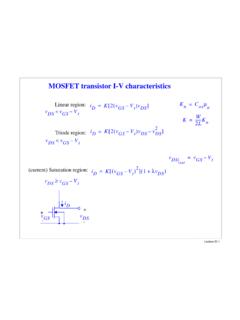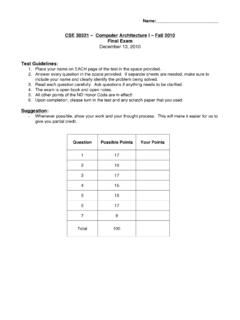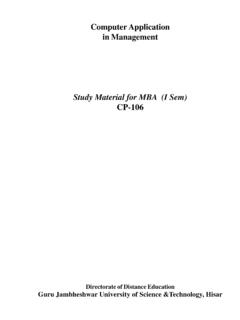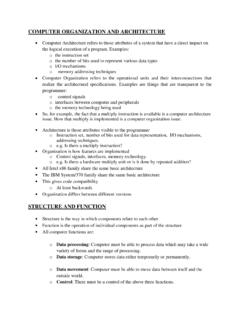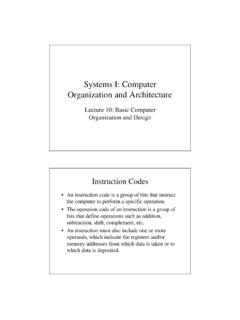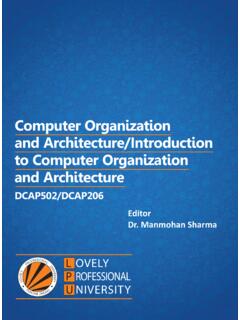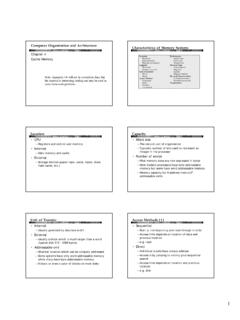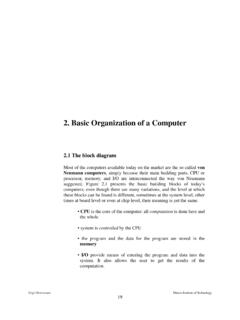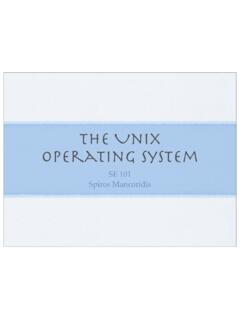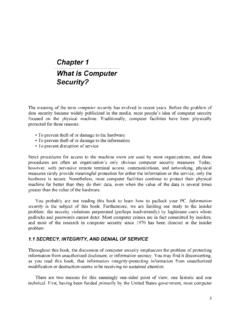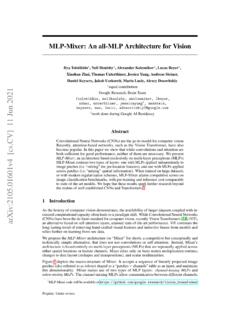Transcription of Computer Architecture: Dataflow (Part I)
1 Computer architecture : Dataflow (Part I) Prof. Onur Mutlu Carnegie Mellon University A Note on This Lecture n These slides are from 18-742 Fall 2012, Parallel Computer architecture , Lecture 22: Dataflow I n Video: n 2 Some Required Dataflow Readings n Dataflow at the ISA level q Dennis and Misunas, A Preliminary architecture for a Basic Data Flow Processor, ISCA 1974. q Arvind and Nikhil, Executing a Program on the MIT Tagged-Token Dataflow architecture , IEEE TC 1990. n Restricted Dataflow q Patt et al., HPS, a new microarchitecture: rationale and introduction, MICRO 1985. q Patt et al., Critical issues regarding HPS, a high performance microarchitecture, MICRO 1985.
2 3 Other Related Recommended Readings n Dataflow n Gurd et al., The Manchester prototype Dataflow Computer , CACM 1985. n Lee and Hurson, Dataflow Architectures and Multithreading, IEEE Computer 1994. n Restricted Dataflow q Sankaralingam et al., Exploiting ILP, TLP and DLP with the Polymorphous TRIPS architecture , ISCA 2003. q Burger et al., Scaling to the End of Silicon with EDGE Architectures, IEEE Computer 2004. 4 Today n Start Dataflow 5 Data Flow Readings: Data Flow (I) n Dennis and Misunas, A Preliminary architecture for a Basic Data Flow Processor, ISCA 1974. n Treleaven et al.
3 , Data-Driven and Demand-Driven Computer architecture , ACM Computing Surveys 1982. n Veen, Dataflow Machine architecture , ACM Computing Surveys 1986. n Gurd et al., The Manchester prototype Dataflow Computer , CACM 1985. n Arvind and Nikhil, Executing a Program on the MIT Tagged-Token Dataflow architecture , IEEE TC 1990. n Patt et al., HPS, a new microarchitecture: rationale and introduction, MICRO 1985. n Lee and Hurson, Dataflow Architectures and Multithreading, IEEE Computer 1994. 7 Readings: Data Flow (II) n Sankaralingam et al., Exploiting ILP, TLP and DLP with the Polymorphous TRIPS architecture , ISCA 2003.
4 N Burger et al., Scaling to the End of Silicon with EDGE Architectures, IEEE Computer 2004. 8 Data Flow n The models we have examined in 447/740 all assumed q Instructions are fetched and retired in sequential, control flow order n This is part of the Von-Neumann model of computation q Single program counter q Sequential execution q Control flow determines fetch, execution, commit order n What about out-of-order execution? q architecture level: Obeys the control-flow model q Uarch level: A window of instructions executed in data-flow order execute an instruction when its operands become available 9 Data Flow n In a data flow machine, a program consists of data flow nodes n A data flow node fires (fetched and executed) when all its inputs are ready q when all inputs have tokens n Data flow node and its ISA representation 10 Data Flow Nodes 11 Data Flow Nodes (II) n A small set of Dataflow operators can be used to define a general programming language Fork Primitive Ops + Switch Merge T F T F T T + T F T F T T Dataflow Graphs {x = a + b.}
5 Y = b * 7 in (x-y) * (x+y)} a b + *7 - + * y x 1 2 3 4 5 n Values in Dataflow graphs are represented as tokens n An operator executes when all its input tokens are present; copies of the result token are distributed to the destination operators token < ip , p , v > instruction ptr port data ip = 3 p = L no separate control flow Example Data Flow Program 14 OUT Control Flow vs. Data Flow 15 Static Dataflow n Allows only one instance of a node to be enabled for firing n A Dataflow node is fired only when all of the tokens are available on its input arcs and no tokens exist on any of its its output arcs n Dennis and Misunas, A Preliminary architecture for a Basic Data Flow Processor, ISCA 1974.
6 16 Static Dataflow Machine: Instruction Templates Each arc in the graph has an operand slot in the program Presence bits 1 2 3 4 5 + 3L 4L * 3R 4R - 5L + 5R * out a b + *7 - + * y x 1 2 3 4 5 Static Dataflow Machine (Dennis+, ISCA 1974) <s1, p1, v1>, <s2, p2, v2> FU FU FU FU FU Op dest1 dest2 p1 src1 p2 src2 1 2 .. Receive Send Instruction Templates n Many such processors can be connected together n Programs can be statically divided among the processors Static versus Dynamic Dataflow Machines 19 Static Data Flow Machines n Mismatch between the model and the implementation q The model requires unbounded FIFO token queues per arc but the architecture provides storage for one token per arc q The architecture does not ensure FIFO order in the reuse of an operand slot n The static model does not support q Reentrant code n Function calls n Loops q Data Structures 20 Problems with Re-entrancy n Assume this was
7 In a loop n Or in a function n And operations took variable time to execute n How do you ensure the tokens that match are of the same invocation? 21 Dynamic Dataflow Architectures n Allocate instruction templates, , a frame, dynamically to support each loop iteration and procedure call q termination detection needed to deallocate frames n The code can be shared if we separate the code and the operand storage <fp, ip, port, data> frame pointer instruction pointer a token A Frame in Dynamic Dataflow 1 2 3 4 5 Program + * - + 3 1 2 4 5 3L, 4L 3R, 4R 5L 5R out * 1 2 4 5 7 a b + *7 - + * y x 1 2 3 4 5 Need to provide storage for only one operand/operator <fp, ip, p , v> 3 Frame L Monsoon Processor (ISCA 1990)
8 Instruction Fetch Operand Fetch ip fp+r Network Network Frames op r d1,d2 Code Form To ke n ALU To ke n Queue Concept of Tagging n Each invocation receives a separate tag 25 Procedure Linkage Operators f get frame extract tag change Tag 0 change Tag 0 Graph for f change Tag 1 a1 1: change Tag n an n: .. change Tag 1 Fork token in frame 0 token in frame 1 Like standard call/return but caller & callee can be active simultaneously Function Calls n Need extra mechanism to direct the output token of the function to the proper calling site n Usually done by sending special token containing the return node address 27 Loops and Function Calls Summary 28 Control of Parallelism n Problem: Many loop iterations can be present in the machine at any given time q 100K iterations on a 256 processor machine can swamp the machine (thrashing in token matching units) q Not enough bits to represent frame id n Solution.
9 Throttle loops. Control how many loop iterations can be in the machine at the same time. q Requires changes to loop Dataflow graph to inhibit token generation when number of iterations is greater than N 29 Data Structures n Dataflow by nature has write-once semantics n Each arc (token) represents a data value n An arc (token) gets transformed by a Dataflow node into a new arc (token) No persistent n Data structures as we know of them (in imperative languages) are structures with persistent state n Why do we want persistent state? q More natural representation for some tasks? (bank accounts, databases.)
10 Q To exploit locality 30 Data Structures in Dataflow .. P P Memory n Data structures reside in a structure store tokens carry pointers n I-structures: Write-once, Read multiple times or q allocate, write, read, .., read, deallocate No problem if a reader arrives before the writer at the memory location I-fetch a I-store a v I-Structures 32 Dynamic Data Structures n Write-multiple-times data structures n How can you support them in a Dataflow machine? q Can you implement a linked list? n What are the ordering semantics for writes and reads? n Imperative vs. functional languages q Side effects and mutable state vs.





